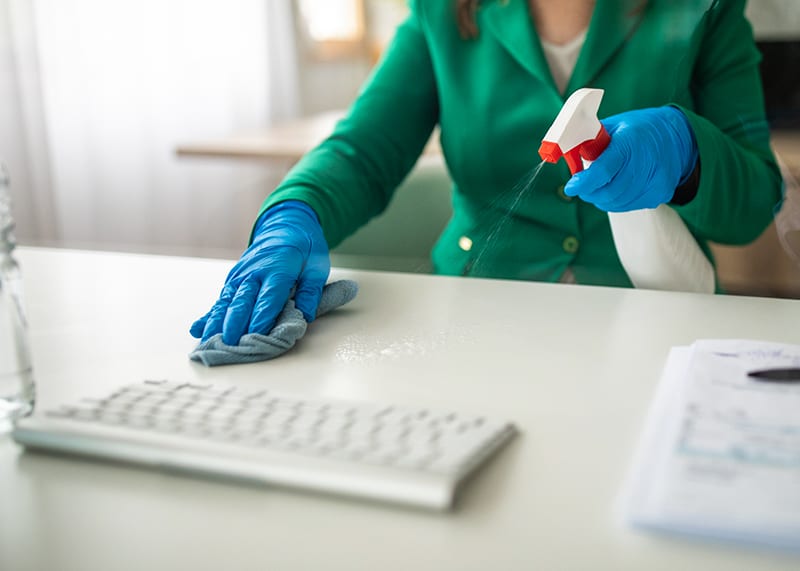When the pandemic lockdown happened, we left our offices in a hurry. One day we were chatting around the watercooler, and the next we were balancing laptops on kitchen tables and transforming unused corners into Zoom backgrounds.
Now that we’re finally returning to the workplace, the prospect of seeing your old desk for the first time in months might seem daunting. Perhaps you never had the opportunity to properly tidy your desk before leaving everything behind, and while the rest of the office will have been redesigned around new social distancing guidelines, for better or for worse, your desk may have been preserved exactly as you left it.
According to research by the University of Arizona, our desks are home to some of the dirtiest and most germ-ridden surfaces we come into contact with. Now, and for as long as the COVID-19 pandemic lasts, keeping a clean and tidy workstation is taking on heightened importance. New and enhanced sanitization measures will be needed to help prevent the spread of the disease in the workplace.
To help you get your workstation back in shape, let’s take a look at the best way to clean your office desk during COVID-19, as well as tips on how to clean and disinfect some common desk accessories.
Before you clean your desk
You need a game plan before tackling a messy desk. Otherwise, you will be overwhelmed and might make the task more complicated than it needs to be.
Start by grabbing any trash and recyclables and place them in the appropriate bins. Check through stacks of paper for anything too important to get rid of, shred anything that’s sensitive—like documents and printouts containing financial or personal information—and throw everything else into paper waste recycling bags.
For a deep clean, you’ll first need to remove everything from your desk so you can easily reach every inch of surface space. That includes notebooks and diaries, fidget spinners, that cute family photo from your most recent vacation, that plant that didn’t get watered, and your keyboard and mouse. Place everything in a pile nearby and arrange or discard the items as you move them back to the desk.
If you’re working in a WeWork office, you might be able to skip this step and begin cleaning the contents of your desk where they stand. Enhanced sanitization practices mean that surfaces throughout the building are cleaned and disinfected more often, including the surfaces of desks in common areas and private offices.
How to clean your desk

First, unplug everything. Don’t just switch things off. Powered-down electronics will usually carry a small standby current that can become dangerous or damaging if circuitry comes into contact with cleaning fluids. It’s also easier to move things around if they’re not still attached to a power outlet, so take the extra precaution of properly disconnecting monitors, keyboards, mice, desk fans, and other electronics before proceeding.
Should you use disinfectant wipes or soap?
Once the power is off, start with the stuff that’s on top of your desk before tackling the assorted computer accessories and the contents of desk drawers. The office equipment and paraphernalia that you use most often, such as pens, staplers, scissors, calculators, and tape dispensers, should be thoroughly wiped down using alcohol-based, antibacterial disinfectant wipes.
Move on to the objects around your desk that you’re less likely to touch, such as lamps, fans, and plant pots. Ensure you wipe all the sides of each item and allow them to dry for five minutes before placing them back on the desk.
Any desktop accessories that are too awkwardly shaped to properly clean with a disinfectant wipe should be washed with mild dish soap and warm water. Things like desk organizers, pen holders, and plastic file holders can all be cleaned in warm, soapy water and left out to air-dry.
Disinfecting your office desk’s surface
If you’ve cleared off your desk completely, this is your opportunity to wipe down every surface with a dry cloth to remove any accumulated dust. Once that’s done, you can use disinfectant wipes to clean the entire surface, making sure to pay particular attention to the parts of the desk that you touch most often, such as desk edges and the areas surrounding the keyboard. For effective disinfecting, let surfaces dry out for around five minutes.

In addition to WeWork’s regular cleaning routines, we’ve increased sanitization protocols to keep office spaces safe and healthy for workers. Surfaces in common areas that are regularly touched by more than one person are disinfected more frequently and during business hours to help prevent the spread of COVID-19. So even if you’re not working out of a private office, or if you take advantage of the different spaces in your WeWork location, you can still feel confident that your workspace has been recently sanitized.
How to clean electronics, furniture, and personal items
With your desk’s surface thoroughly wiped down and disinfected, it’s time to move on to cleaning your devices, computer peripherals, and desk accessories. Before continuing, ensure everything has been fully disconnected from the power outlets. Remember: Moisture and electronics don’t mix.
How to clean your computer screen
Over time, dust, dirt, and oily smudges can build up on your monitor, especially if you have a habit of touching the display when pointing something out. Cleaning a computer screen requires a little more care and attention than other items on your desk, so here are some tips for cleaning your monitor to avoid causing damage to the delicate components.
As a rule, don’t apply cleaning products directly to the display. Liquids can permeate the thin outer layer of the screen, seep into the monitor, and cause damage, clouding, and discoloration. Instead, wet a clean microfiber cloth with cold water and thoroughly wring it out before wiping the screen using long, side-to-side strokes. Avoid using paper towels or rougher types of cleaning cloths as they may scratch or dull the screen.

Harsh, chemical-based cleaning agents like Windex aren’t suitable for use on monitors, as they can strip away the display’s anti-glare coating, so always check a cleaning product’s usage instructions before you begin. A damp microfiber cloth should clear most smudges, but if your screen is especially filthy, use a mixture of 50 percent white vinegar and 50 percent distilled water to cut through heavy grease.
The best way to clean a monitor is to avoid getting it dirty in the first place. Train yourself to never touch the screen and you’ll rarely have to wash it.
How to clean your keyboard
All of those lunch breaks spent working at your desk can take their toll on your faithful keyboard. Hold the keyboard upside down above a trash can. Tap and shake it firmly to dislodge any crumbs, seeds, and other unpleasant detritus that may have fallen between the keys. While still tilting the keyboard, use a can of compressed air aimed between the keys to blast away any remaining loose debris.
Once the larger particles of dirt have been removed, wash the keyboard using disinfectant wipes or an alcohol-based cleaning agent. Run the wipe or cloth between and around individual keys, paying particular attention to frequently used keys such as the space bar and enter key. Ensure the cloth you’re using isn’t too wet, and allow the keyboard to dry out for at least 10 minutes after cleaning, as excess liquid can damage the hardware under the keys.
The average computer keyboard is infamously reported to contain anywhere between 400 and 20,000 times more bacteria than a toilet seat, so focus on thoroughly sanitizing your keyboard regularly to prevent it from becoming a health hazard. Some keyboards allow you to remove individual keys, giving you access to the areas where most of the dirt gathers for a deep clean.
How to clean your mouse
While optical mice are far less susceptible to collecting grime than older, mechanical mice, they can still accumulate dirt and bacteria on their undersides and where the mouse comes into contact with your hand and fingers.
To clean your mouse, place it on a paper towel to catch any falling dirt, then run a toothpick or a folded sticky note along the small gaps between the buttons and the body of the mouse to dislodge any built-up grime. Compressed air can be used to remove any leftover debris.

Use a disinfectant wipe or cloth treated with an alcohol-based cleaning agent to gently sanitize the surface of the mouse, paying particular attention to the left and right mouse buttons where bacteria from fingers tend to collect.
How to clean your office chair
The best way to clean your office chair depends on the type of upholstery. Check the laundry tag—it’s usually stitched into the underside of the seat—for cleaning instructions and guidance on what products can be used to remove stains.
If your office chair can be cleaned with water-based cleaning products, first vacuum the seat to remove loose dirt and debris before mixing a solution of mild dish soap and warm water. Spot test an inconspicuous part of the fabric and allow it to dry before continuing, then check for any discoloration or damage to the material once it’s dry. If everything looks good, use a cloth to gently clean the rest of the chair.
For office chairs that are labeled dry-clean only, use a water-free product or specialized dry-cleaning solvent. You can find these kinds of cleaners in furniture stores and some office supply stores. Vacuum the chair afterward to remove any residue.

To disinfect your office chair, wipe down the armrests using a disinfectant wipe or alcohol-based cleaner, making sure to run the wipe across the undersides of each armrest and along any other metal or plastic parts of the chair, such as the adjustment lever and backrest.
Most wipes are not suitable for use on porous materials like fabric, so if your office chair has upholstered armrests, use the tips above to thoroughly clean and sanitize them. Consider swapping these kinds of armrests for more easily sanitized alternatives such as hard plastic, metal, or polyurethane.
How to clean your laptop
Treating your mucky laptop to a deep clean can make it feel brand-new again. Once you’ve fully powered down the laptop and, if possible, removed the battery, use a can of compressed air to blast away any crumbs, hair, and debris from the cracks and crevices. Pay special attention to the gaps between the keys, the insides of USB ports, and along vents. Keep the can upright and use short bursts of air to avoid introducing moisture to the internal hardware.
Now wipe down the outside surfaces and the keyboard using a microfiber cloth lightly dampened with an alcohol-based cleaner or a mixture of two parts rubbing alcohol and one part water. This will gently lift off any accumulated grime deposited by your fingers over time.
To clean the laptop screen, use a fresh, dry microfiber cloth to avoid scratching the delicate display. This should remove any fingerprints, but for tougher stains, you can use a mixture of 50 percent white vinegar and 50 percent water to lift off grease. Make sure to wring out any excess liquid from the microfiber cloth before wiping the screen to avoid moisture becoming trapped under the display.
To disinfect your laptop, run a disinfectant wipe along the keyboard, the touchpad, and the external surfaces of the machine, focusing on high-touch areas such as the space bar, the upper edge of the lid, and the power button.
How to clean your water bottle
Your reusable water bottle can collect harmful bacteria and should be washed at the beginning or end of each day, especially if you’re filling it with anything that isn’t water.
For daily cleaning, immerse the bottle in a sink filled with warm, soapy water and scrub it inside and out using a bottle brush. Or put it through the dishwasher if the bottle is labeled as dishwasher safe. Leave the bottle upturned and with the cap off to allow it to air-dry.
If your reusable water bottle is beginning to smell a little funky, it’s time for a deeper clean. Fill the bottle with a mixture of 50 percent white vinegar and 50 percent cold water and let it sit overnight, before thoroughly rinsing it out or running it through the dishwasher.
How to clean your desk phone
Your desk phone is especially prone to collecting germs and bacteria spread from your mouth and hands, and should be wiped down with a disinfectant wipe once per day and immediately after it’s been used by another person.
Unplug the phone so that you don’t accidentally call anyone, then run the wipe over every surface, paying particular attention to the handset, mouthpiece, and keypad. For a deeper clean, use a cotton ball soaked in rubbing alcohol to get into every nook and cranny.
How to clean your headphones
If you wear a pair of headphones at your desk, it’s a good idea to clean and sanitize them regularly. Once a week, wipe down the hard exterior surfaces using an alcohol-based disinfectant wipe, then dab the insides using sticky tack to lift off any loose dirt or debris.

Clean the earpads using soap, water, and a damp microfiber cloth, being careful not to damage the delicate foam padding. Allow the headphones to dry out completely before using them again.
How often should you clean your desk?
If you’re using your desk every day, you should aim to thoroughly clean and disinfect it once every two weeks. Between these deeper cleanings, aim to sanitize high-touch points such as desk phones, keyboards, and mice once a day.
- Make it a habit to spend a minute or two wiping down accessible surfaces, desk phones, and peripherals such as keyboards and mice with a disinfectant wipe every night before leaving the office.
- Integrate a regular desk cleaning routine into your schedule by setting a calendar reminder to spend five minutes cleaning and resetting the desk on a specific day of the week. Monday mornings work best for most people, as it leaves you with a clean desk for the rest of the week.
- Deeper cleans can be less frequent. Consider creating a team appointment once a month, where everyone takes the time to clear their desks and thoroughly wipe down all surfaces and computer accessories.
- Tidy as you go along. The less trash you accumulate on your desk over the course of the week, the easier it is to clean.
At WeWork, common areas are being cleaned more frequently than ever, and desks and chairs in private offices are sanitized once every seven to ten days. We also ask WeWork members to follow a new “clean desk strategy” to ensure our enhanced cleaning regimen is as thorough as possible. That means all desks should be cleared at the end of each day, except for monitors and laptop stands, so that our cleaning crews can access as much of the desk as possible.
Alongside updates like new social distancing guidance, de-densified office layouts, improved air quality, and behavioral signage, the changes we’re making at WeWork are redefining the workplace in the age of COVID-19. A tidy desk is just one piece of that puzzle. By working together, we can adapt for the workplace of tomorrow, prioritizing health, safety, and comfort not just in the places we sit, but in every corner of the office.
Steve Hogarty is a writer and journalist based in London. He is the travel editor of City AM newspaper and the deputy editor of City AM Magazine, where his work focuses on technology, travel, and entertainment.
Rethinking your workspace?








